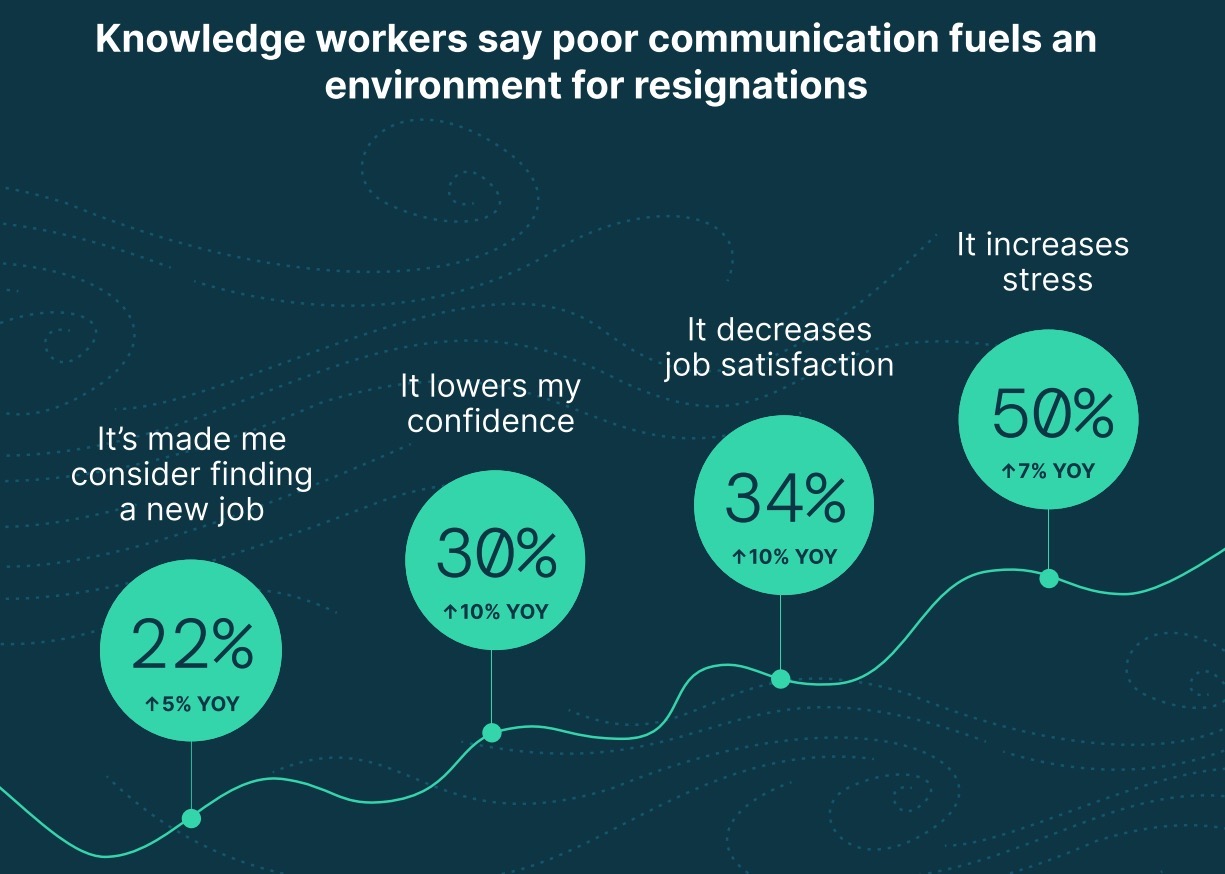
Poor Workplace Communications Can Have Massive Bottom Line Implications: Survey
March 6, 2023 by Dave Haynes
Workplace communications is a very active vertical in digital signage – both in white collar and operational environments – because of the recognition by end-user customers that better, more timely and relevant messaging is perhaps more important than ever.
Some digital signage software companies – like Appspace, Poppulo (Four Winds) and NDS (Netherlands) – have made workplace their main focus, while many others include it among their key markets to chase.
Anyone selling into that segment would likely benefit from downloading this free report from a San Francisco company called Grammarly, which markets AI-enabled communication assistance software for business communicators. Grammarly’s second annual Grammarly Business “State of Business Communication: The Path to Productivity, Performance, and Profit” report suggests communicating effectively at work is a growing challenge for U.S. businesses and employees. In partnership with The Harris Poll, the study shows deepening effects of poor communication on everything from productivity to stress, confidence, and job satisfaction.
To be clear here, the report is focused on written communications, but provides a lot of rich detail about the overall challenges and impacts of workplace messaging, particularly as businesses wrestle with hybrid and remote working arrangements.
From the PR on the report (a free download but you need to give them your email):
Effective communication is essential to meet new business, customer, and workforce demands as organizations navigate continued market pressures and workplace transformation. The data shows we’re communicating more than ever across channels, but its effectiveness is waning. Employees spent 18% more time year-over-year (YoY) communicating in writing, and both workers and leaders are using more asynchronous communication (communication that is not in real time or does not expect immediate responses). Yet, leaders report a 12% drop in the effectiveness of written communication over the same period—and “decreased productivity” as a result (+15% YoY).
“The research is clear: Leaders who shrug off the massive impact of poor communication on their bottom line will lose,” said Matt Rosenberg, Grammarly’s Chief Revenue Officer and Head of Grammarly Business. “Last year, we found that ineffective communication costs U.S. businesses up to $1.2 trillion annually, or $12,506 per employee. This year’s report shows the problem is getting worse with greater impact on everything from operational efficiency to employee and customer satisfaction. At a time when the stakes are critically high, leaders who invest in empowering efficient, consistent communication across their organizations will see results and profits climb.”
By illuminating the state of communication trends, challenges, and tools, the study of U.S. business leaders and knowledge workers underscores the growing link between communication and company performance in an evolving landscape. Additional findings include:
- Workers now spend over 70% of the workweek communicating on various channels, but most (58%) still wish they had better tools to be more effective—especially Gen Z (63%), Millennial (65%), Tech (68%), and ESL (71%) respondents.
- Over 8 in 10 business leaders (84%) are feeling the downsides of poor communication, with lower productivity, missed deadlines, and increased costs ranking as the top three.
- Workers report increased stress (+7% YoY) due to poor communication, and most leaders (60%) and nearly half (45%) of workers say personal connections have suffered in the hybrid workplace.
Grow—or sacrifice—revenue and results based on communication: Effective communication drives higher internal and external performance, with increased productivity (72%) and customer satisfaction (63%) topping leaders’ list of outcomes. Of those reporting higher customer satisfaction, 69% say that the increase is 10% or more. Yet most leaders (68%) lost at least $10,000 or more in business in the past year due to poor communication—13% even report $50,000+ lost. One in five also say it eroded their brand credibility or reputation.
Prioritize quality and tone for productive collaboration: Leaders (72%) and workers (53%) alike are paying more attention to the tone of messages lately. Most workers (62%) say a positive tone drives a faster response, and Millennials and Gen Zers are especially likely to do higher-quality work based on a positive tone. But the rise in more written and asynchronous communication makes it harder to discern tone—and 63% of workers report spending too much time trying to convey messages in the right way.
Rethink investments to augment teams’ skills and capabilities: Leaders prioritize investments in more processes and platforms instead of empowering teams to communicate better where they already work. They consider the platform of communication as “very important” (66%), but only 36% of workers say the same—ranking it last after aspects like content, tone, and empathy. While eight in 10 leaders are considering AI tools to augment employees to be more productive and effective, it’s not in their top three investment areas to improve communication—with better processes and strategies topping the list (88%).




Leave a comment